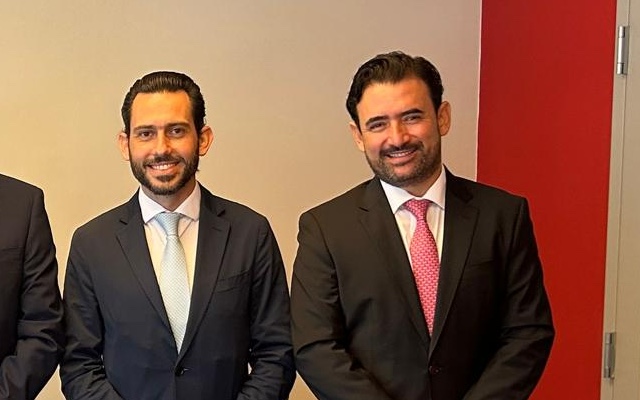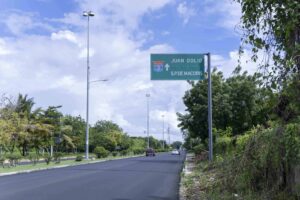

The heads of the State Secretariat of Tourism (Sedetur), the Tourism Promotion Council (CPTQ) and the Integral Port Administration of Quintana Roo (APIQROO) took a new turn in a visit to the United States to focus on curbing insecurity in the entity that shelters Cancun, Riviera Maya and Tulum.
The Quintana Roo delegation, headed by the head of Sedetur, Bernardo Cueto Riestra, who represented Governor Mara Lezama Espinosa, had a meeting with the United States Department of State, led by Max Hamilton, Head of the Western Hemisphere Bureau of Mexico (Criticism of the CPTQ: Cozumel or Holbox, far from entertainment).
At the meeting, which was also attended by the general director of APIQROO, Vagner Elbiorn, and the CTPQ, Andrés Martínez Reynoso, the technological advances in tourist security promoted by the state government were shared, including the Guest Assist and Guest Locator systems, designed to protect and assist national and international tourists.
The Quintana Roo delegation also met with the Mexican Ambassador to the United States, Esteban Moctezuma Barragán, where the promotion of the state’s 12 tourist destinations through the diplomatic office and the 51 Mexican consulates in the United States was highlighted.
Previously, Andrés Martínez Reynoso, pointed out a few days ago, as reported REPORTUR.mxthat the evolution of Quintana Roo will be to go from being the best sun and beach destination in the world, to being the best sun, beach and entertainment destination in the world.
In this regard, he explained that the next evolution of the Mexican Caribbean will be entertainment, as there are more and more festivals and concerts, and all the hotels have a great entertainment offering, “we have the Nickelodeon Hotel for children, Cirque Soleil, concerts all the time, and I think the next evolution is that we are already the best sun and beach destination in the world, now we will be the best sun, beach and entertainment destination in the world,” he told Wradio.
Andrés Martínez Reynoso added that “we have very powerful brands, we have Cancún, Tulum, even Playa del Carmen and the structure we created is a plural architecture, it is a way of grouping them, taking advantage of the fact that we have large, powerful brands with destinations that are not as well-known, such as in the south of the state where there are some gems, such as Bacalar, Mahahual, or the island of Holbox in the north or Isla Mujeres opposite Cancún, Puerto Morelos which has sought its own identity around gastronomy.”
However, this focus on concentrating the promotion of the destination on entertainment is concentrated in the largest destinations in the entity, such as Cancun and Riviera Maya, which have nearby leisure offerings, unlike others such as Holbox or Cozumel, whose appeal is based on sun and beach (CPTQ: QRoo will not only be a world leader in sun and beach but also in entertainment).
Thus, the change promoted by Andrés Martínez Reynoso to reposition Quintana Roo’s marketing received private criticism from experts in the sector, since they consider that the destinations most in need of support are somewhat excluded from the promotion if the change of focus begins to highlight entertainment that is more difficult to access from islands, for example.
Tourists also expressed their opinion REPORTUR.mx his disapproval of the change in strategy promoted by Governor Mara Lezama and the director of the Quintana Roo Tourism Promotion Council (CPTQ), Andrés Martínez Reynoso, who will centralize the projection of the destination in the Mexican Caribbean brand, to the detriment of the 12 sub-brands as until now.
Those consulted by this newspaper affirm that this change also represents a benefit to competing destinations, since the entire Caribbean is implicitly promoted, and the Mexican region is considered only as part of a large region (Lezama and the CPTQ are criticized for centralizing QRoo in a brand).
Likewise, the new strategy hinders the positioning that emerging areas of Quintana Roo had been achieving, especially those in the south –Bacalar, Mahahual, Chetumal…–, for which a broad Hotel development program was expected, as they could be supported by the Mayan Train and the Tulum airport.
Similarly, it is pointed out that centralizing all the diversity of the entity in a single brand goes against what is used and known by the client, who usually refers to Cancun, Riviera Maya or Tulum when explaining their vacation destination.
In this sense, the great recognition of these three brands with differentiated products is harmed without precisely because of this a single centralized brand hinders the expression of their respective singularities (QRoo presents Caribe Mexicano New Era with the evolution of its product).




